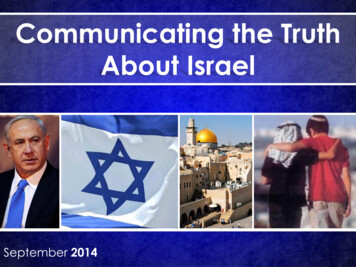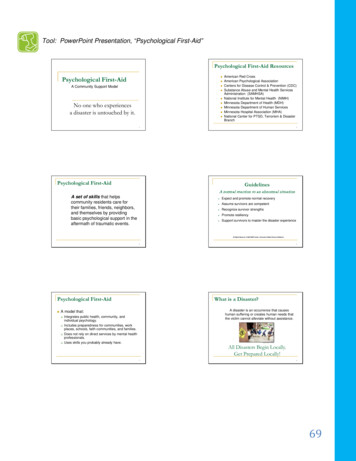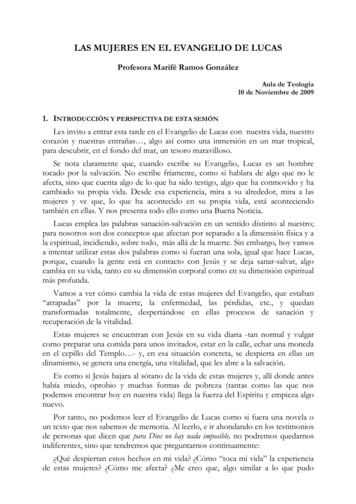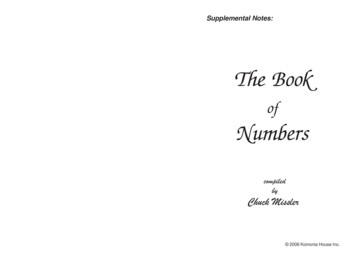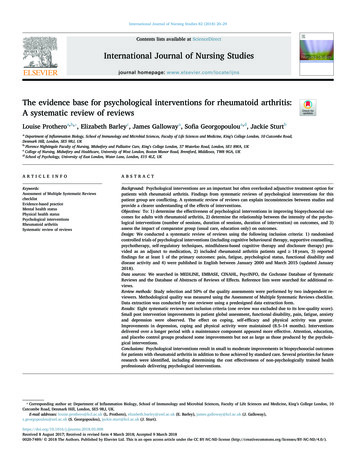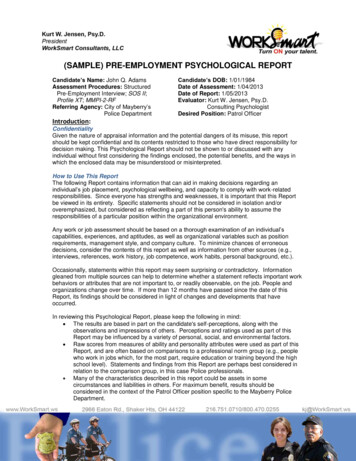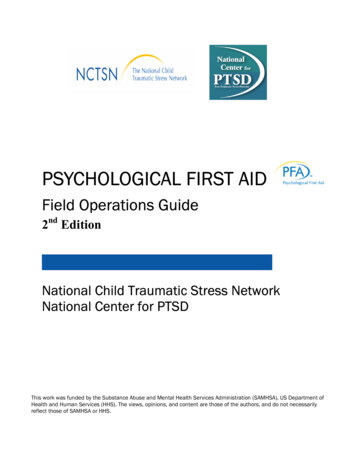
Transcription
DdFaculty of Social ScienceBachelor ThesisIsrael’s usage of PsychologicalWarfare against HezbollahTheoretical Development and ApplicationAuthor: Felicia LindqvistSupervisor: Anders PerssonExaminer: Daniel SilanderTerm: Fall 19Subject: Political scienceLevel: Bachelor ThesisCourse code: 2SK31E
AbstractThe purpose is to analyze and describe Israel's psychological warfare facingHezbollah in the years between 2017-2019. The question at issue is: How hasIsrael used Psychological Warfare against Hezbollah between 2017-2019?This is revised through a theory development using the work of Martin C.Libicki (1995), Ron Schleifer (2009), Paul Linebarger (2015), and Irwin J.Mansdorf (2015), along with the use of the previous historical practice ofpsychological warfare by Israel. The material is acquired from Israel'sdifferent types of social media platforms along with key articles on the subject.This aiming to determine the psychological warfare done by Israel. Thetheoretical development does create valuable and at most necessary aspects ofpsychological warfare that would if unnoticed give an insufficient analysis anddescription of the psychological warfare for this case. The research uses theoryapplication to generate the conclusion and to describe the PSYOP. The resultof this work shows the extensive use of psychological warfare by Israel.Between the years of 2017-2019, a massive social media presence from Israelis noted and one can locate a psychological warfare message in nearlyeverything. Israel put in great effort to influence Hezbollah and the fight formedia coverage and news influence is the big focus for Israel.Keywords: Psychological warfare, PSYOP, Israel, Hezbollah, Theorydevelopment.2 (46)
Table of ContentsAbstract1. Ingrained Psychological Warfare . 51.1 Research problem . 51.2 Purpose . 61.3 Delimitations . 72. Previous research . 72.1 Psychological warfare . 72.2 Definition of Psychological Warfare . 102.3 Contemporary research . 113. Israel’s previous Psychological Warfare . 123.1 Second Intifada 2000-2005 . 123.2 Lebanon war 2006 . 134. Theoretical framework . 164.1 Counter-will. 174.2 Counterforces . 174.3 Counter-commander . 184.4 Cultural/Ideological conflict . 184.5 Political Leaders . 194.6 Operationalization. 205. Research design . 215.1 Case study. 215.2 Theory development . 225.3 Validity and generalizability . 245.4 Material . 255.5 Criticism of source selection . 265.6 Summary of material . 276.Analysis . 276.1 Counter-will. 276.2 Counterforces . 296.3 Counter-commander . 316.4 Cultural/ideological conflict . 326.5 Political leaders . 347. Conclusion. 377.1 How has Israel used Psychological Warfare against Hezbollah between2017-2019? . 377.2 Theoretical conclusions . 387.3 Material conclusions . 397.4 Future research . 393 (46)
8. References .414 (46)
1. Ingrained Psychological WarfareIsrael has recently increased its distribution of intelligence with the purpose ofinfluencing other states. This not being a new phenomenon from Israel butstill, an increase has been noted (Riemer & Sobelman, 2019). The relationsbetween Israel and Hezbollah have an extensive history of conflict andpsychological warfare (PSYOP), which have been lunged both ways throughdecades. Israel has had some success in the PSYOP used on Hezbollah but thatnot in any way interfering a war or securing them success. Hezbollah still hada stronghold on the military situation after the Lebanon war 2006, which wasthe peak in PSYOP for Israel (Schleifer, 2009, p. 221-238). There is no doubtthat Hezbollah is one of Israel’s biggest obstacle (Nouri, 2017). Israel has withthe technical evolvement, derived its psychological warfare and is puttinglarge scale efforts towards it (Schleifer, 2009, p. 221-238).The cognitive reality of psychological warfare is defined in the techniqueswhen calculating how the enemy feels. Miscalculations can have devastatingconsequences. By defining moral and enemy preconceived notions thereasoning around potential behavior when exposed to psychological warfareis done. That pinpointing the aspect of influence and changing the target mindand behavior (Linebarger, 2015, ch. 2). Psychological warfare has sustainedovertime being a big part of Israel's military structure and will presumablyrefine over time. Today PSYOP’s involve to a large extent targeting keygroups to support the narrative favorable for the agents targeting (Mansdorf,2015, p. 660-663).1.1 Research problemHezbollah's involvement in the Syrian war changed the game plan. In 2013they claimed their full involvement in Syria. That decision was criticized byboth the Lebanese people and other political parties within the Lebaneseparliament. Hezbollah alleged the decision as an act of self-defense but the5 (46)
criticism towards the involvement remained. Because of the Lebanon war of2006, still present, the engagement was not received well (Johansen, 2016, p.12-15). Hezbollah may obtain numerous reasons for this involvement but onebeing the Israeli threat closing upon them and the need for a tighteningstronghold in Syria increased. Since the beginning of the war, Israel haslaunched over a hundred airstrikes specifically targeting Hezbollah and theconnecting Iran (Jones & Markusen, 2018).Hezbollah’s support for the Assad regime stems from the necessity for bothmilitary and political support and the securing of expansion by Hezbollah. Thisalso highlights the goal of consistently provoking and remaining on theopposite side of Israel. Iran and Hezbollah are in Syria an intertwined targetand the distinction between them is difficult to make. Between the years of2017 and 2018 the Center for Strategic & International Studies, (CSIS)addresses the increasing number of airstrikes conducted by Israel targetingboth Hezbollah and Iran. Israel’s goal was to push back the military strengthand positions far away from the border (Jones & Markusen, 2018). InSeptember 2017, Hezbollah’s leader Hassan Nasrallah threatened Israel thatthere would be over 10,000 soldiers by the border ready to fight the Israeli,which elucidated the increase of hostility (Staff, 2017). To make mattersinteresting, during the Lebanese parliamentary election in May 2018,Hezbollah gained favorable relational developments with its allies, increasingseats and power within Lebanon (Hubbard & Saad, 2018). These events andthe engagement in the Syrian war entails an interest in how Israel employedpsychological warfare during 2017-2019. Also, how have PSYOP campaignstowards Hezbollah played out since the rise in hostilities in the Syrian war?1.2 PurposeThe purpose of the thesis is to analyze and describe Israel's use ofpsychological warfare against Hezbollah since the increase in hostilitybetween the years of 2017-2019. A self-constructed theoretical framework will6 (46)
be used when analyzing, along with a theoretical application aiming tocategorize and outline the psychological warfare conducted. How has Israel used Psychological Warfare against Hezbollahbetween 2017-2019?1.3 DelimitationsThis paper aims to through theory application describe the psychologicalwarfare conducted by Israel towards Hezbollah during the time of 2017-2019.The research also aims to through self-constructed theory development,pinpoint the target categories of psychological warfare. This research aims toadd categories to expand the already existing developed by Libicki (1995), toreceive a comprehensive analysis. Based on collecting work from Schleifer(2009), Mansdorf (2015), and Linebarger (2015) along with previousempirical work on the case of Israel, the theory development is implemented.The research does not include how the PSYOP has been received neitheracknowledging its rate of success. It does not include the PSYOP directed fromHezbollah towards Israel. Events from the Syrian war and clashes between theparts in Syria are not mentioned in the material since the work focuses on therelations and events on either Lebanese ground or Israeli ground.2. Previous research2.1 Psychological warfarePsychological warfare has throughout time taken a few different paths and thedefinitions vary depending on the researcher. The research began early, andpsychological warfare has been used in different forms and directionshistorically (Linebarger, 2015, ch. 1). Martin C. Libicki writes in “What isinformation warfare?” (1995) about psychological warfare and presents somefoundational aspects. First explaining PSYOP as using information against the7 (46)
human mind to change it for their own preference. Libicki theorizespsychological warfare as the following: 1, Operations against the national will.2, Operations against opposing commanders. 3, Operations against troops. 4,Operations of cultural conflict. Here focusing on the direction and target of thePSYOP (Libicki, 1995, ch. 6).The research further shifts towards the means used to influence. Psychologicalwarfare has evolved into a more sophisticated process with new technologies.This has increased the influential channels and aiming the warfare to a moredefined goal. The evolvement has also created the assumption that thepsychological effects are particularly influential to the target (Khalilzad, et al.,1999, p. 47). The manipulation of information and the width of the influencehas greatly affected the usage of PSYOPs. Technical ability is the mosteffective tool in the modern time of psychological warfare. When video andrecordings became more effectively gathered, the spread and aim of it couldeasily be distributed towards the selected audience. Controlling whatinformation is being released by other actors is now harder to manage andcomprehend (Khalilzad, et al., 1999, p. 204). The low cost of the moretechnique-based means of PSYOP’s makes it useful for non-state actors andorganizations to enable resources onto (Khalilzad, et al., 1999, p. 208).The research about psychological warfare has taken a few different theoreticalframings. Researchers like Ron Schleifer focused in 2009 on Lasswell'smodels of communication: “Who says What to Whom, in Which Channel andto What Effect”. That framing not being specified for solely psychologicalwarfare. Schleifer theorizes this model together with the U.S. Army manualsfrom 1979 (Schleifer, 2009, p. 222-223). Resulting in using the followingpoints analyzing PSYOP:(a) their selected (enemy) target audience;(b) the goals, covert and overt, they were designed to achieve;(c) the operational principles –i.e., Psychological techniques—used to realize8 (46)
these goals; and(d) the technical means used convey said messages.(Schleifer, 2009, p. 222-223).These points could be appropriate when analyzing psychological warfare butdo not provide the defined target group that can be seen as useful when locatingthe specific means of a PSYOP campaign. Robert L. Perry gives a valid criticto this type of analytical framework used by Schleifer in previous work. Thecritic presented claims that Schleifer's work is not sufficiently organized andhave a lacking in logic. Perry states that the need for a precise definition andoperational structures being vital for the discussion of psychological warfare(Perry & Schleifer, 2008, p. 137-138).Using the U.S. army guidelines in PSYOP research has evolved over time butthe manuals are still extensive work to regard when theorizing. In 2005 thefollowing points were considered to guide the PSYOP campaigns in bothviolent and nonviolent situations to “hasten the eventual defeat of enemyforces” (US. Army, 2005, p. 24). This being operational and tactical levels ofthe objective. Undermining the will of the enemy to resist. Increasing unrest among the civilian population in enemy areas. Increasing desertion or surrender of enemy forces. Reducing civilian interference with military operations. Undermining the credibility of enemy leadership. Reducing damage to elements of infrastructure critical to end-stateobjectives. Increasing acceptance of friendly forces in occupied territory. Deterring intervention of neutral and neighboring powers. Countering propaganda.(U.S. Army, 2005, p. 24).9 (46)
These points are a defined map of how the analytical work should beconducted by the U.S. Army, that which makes the analytical framework to betoo defined and adjusted specifically for the U.S. Army, making theapplication complicated.2.2 Definition of Psychological WarfarePaul Linebarger discusses in his book “Psychological Warfare” (2015) thedefinition of psychological warfare. Psychological warfare is described as acontinuous process in which seeks to win military gains without the usage ofmilitary force. Psychological warfare can be overt or covert in its mission.Linebarger defines psychological warfare as:“Psychological warfare comprises the use of propaganda against anenemy, together with such other operational measures of a military,economic, or political nature as may be required to supplementpropaganda.” (Paul Linebarger. 2015, p. 58).Here focusing on the term propaganda as the big player in psychologicalwarfare (Linebarger, 2015, p. 58). Propaganda does not include the plannedoperations not played out as the traditional communication platforms for themass (Linebarger, 2015, ch. 3). Moving away from this to focus more onpsychological warfare as a method to pinpoint the essence of PSYOP’s,propaganda is not included in the following.Psychological warfare is an essential part of modern warfare and is conductedin the area between civil society and the battlefield (Ottosen, 2013, p. 73).Psychological warfare as a method has done a journey from having the aim oflowering enemy morale to benefit military objectives and using it as a "softpower" tool, influencing and not coercing. Then shifting on to the more wellknown traditional types of psychological warfare of affecting the enemysoldiers, enemy civilians and then moving on to the enemy governments anddecisionmakers (Mansdorf, 2015, p. 649-650). In all PSYOP campaigns, it is10 (46)
necessary to clarify and identify the opponent's fundamental levers so there isa clear target for the neutralization, and for the PSYOP to affect their will forhostilities (Schleifer, 2009, p. 227). Irwin J. Mansdorf (2015) describes therising need for relating aspects traditionally more used in "Public diplomacy".Here focusing on terms like "informing and influencing foreign publics",aiming at other groups, not just enemies. Mansdorf, however, claims thatpsychological warfare has necessary scientifically and researched techniquesof procedures. Here arguing that psychological warfare is based on rationaldetermination and evidence-based logic, drawing more on scientific logic,than acting on personal opinion and individual perception (Mansdorf, 2015, p.649-650).Psychological warfare, is according to Mansdorf defined in the most elaborateand detailed way as:“Planned operations that convey selected information and indicators toforeign target audiences to influence their emotions, motives, objectivereasoning, and ultimately, the behavior of foreign governments,organizations, groups, and individuals.” (Irwin J. Mansdorf 2015, p.659).2.3 Contemporary researchThe means of delivery for the information of persuasion have historically been,mass media, paper leaflets, radio, and newspapers. Today the process ofinfluence is more adapted to new technology and PSYOP uses social mediachannels and email along with other social networks to get the message across(Schleifer, 2014, p. 155). Kuntsman & Stein explains this as a form of digitalmilitarism. Digital militarism is a phenomenon that aims to describe theprocess in military power that the digital platforms and social media have. Theincreasing use of digital tools came with the twenty-first century'stechnological increase and development. Media have become a tool for11 (46)
military advancement both for the state and for nonstate actors. This draws onaspects to influence the minds and actions of others by channels likeInstagram, Facebook, and YouTube. Today the militarization and influencefrom actors like the Israeli state additionally using surveillance and havingcounterinsurgency in the toolbox (Kuntsman & Stein, 2015, p. 6-7).3. Israel’s previous Psychological WarfareIsrael is a well-known user of psychological warfare campaigns and forhistorical context, the use of psychological warfare in the Second Intifada2000-2005 and the Lebanon war of 2006 will be presented. This to give thenecessary background that acts as the historical base of the psychologicalwarfare used by Israel.3.1 Second Intifada 2000-2005The PSYOP used by Israel during the Second Intifada took different paths butmedia presence was what permeated. The target for the media campaigns wasmerely to paint the picture of brutal terrorists, the Arabs. Israel put a massiveeffort in creating the image of the enlightened people of Israel and the horribleArabs. Israeli media focused on broadcasting pictures of the suffering made tothe soldiers and population in Israel while holding back broadcasts of thesuffering made to the Arabs. This to influence the general public, foreignactors, the Arabs, and the Israeli citizens. Palestine answered by projecting theopposite appearance of the Palestinians being the suffering people and theIsraeli to be the horrible oppressor (Wolsfeld, 2003, p. 1-5). Israel startedunder the Second Intifada (2000-2005) developing PSYOP techniques moreextensively and the Israeli Defense Forces (IDF) coined in connection toPSYOP the aspect of: "burning into the enemy’s consciousness” (Schleifer,2014, p. 154).12 (46)
3.2 Lebanon war 2006Ryan Schleifer (2009) writes about the psychological warfare campaign onHezbollah from Israel during the Lebanon war 2006, using Lasswell's modelof communication: who says what to whom, in which channel and to whateffect. This along with U.S. Army PSYOP field manuals. Israel's use ofPSYOP’s has increased over time but the major shift in practice started in thelate 1990s when the repercussion of targeting the minds and using persuasionwas raised as powerful in war and conflict for Israel. The Lebanon war in 2006came inconveniently as Israel was recovering from the ongoing conflict inGaza and the Second Intifada. This affecting the strength of Israel in variousaspects such as military and politically but also psychological (Schleifer, 2009,p. 223-226). The Lebanon war in 2006 lasted 34 days and the IDF was poorlyprepared for Hezbollah. This failure of a war for Israel increased the IDFintelligence gathering and they now needed to improve their knowledge toprevent this from happening again (Harel, 2016). Hezbollah further carried outa verbal smear campaign against Israeli soldiers creating an impression thatthe capabilities of IDF were limited. This along with many other factorsleading to the targeting of Hezbollah and especially its leader Nasrallah. Israelalso focused the PSYOP campaigns on its opponents, supporters and theLebanon general public for the campaign to be as immense as possible(Schleifer, 2009, p. 223-226).Kuntsman & Stein defines Israel’s different ways of exploring the increase indigital militarisation, that in both the private spheres of the individualsworking within the IDF and the more public influence such as Twitter whichis frequently used to publicly spread information (Kuntsman & Stein, 2015, p.20-22). Benjamin Netanyahu the Israeli prime minister is also a bigcontributor, his speeches and social media presence is large and considerable.Together with Israel's media outlets, the transmission of information andimages published per effect both the Israeli people but also their opponents13 (46)
(Kuntsman & Stein, 2015, p. 9-10). Schleifer's (2009) analysis regarding thissuggests two main objectives. The first one being a military-oriented goalsecuring the northern parts of Israel. The second being to a more politicalextent, to insecure and threaten Hezbollah's position in Lebanon. In the aim ofthe political aspect, Israel focused on undermining Nasrallah’s position withinHezbollah, driving a wedge between the Lebanon Shi'ite community and theHezbollah, weakening Hezbollah. To impair a leader is a difficult undertakingwith the potential exposure of backfire and increasing the enemy leaders'support. In 2006 Israel launched a massive PSYOP campaign against theHezbollah leader Nasrallah intending to sabotage the prominent structure ofHezbollah. Here drawing on humor as the collector of the gathering of criticalthinking, creating amusement concerning the leader to establish a way in,affecting the minds. Affecting people's opinions and constructing Nasrallah asHezbollah, personalizing the message and connecting everything Hezbollahdoes as Nasrallah as a person (Schleifer, 2009, p. 227-230).Israel in its determination to cover messages, realized the popularity inLebanon concerning a radio broadcaster mixing the content with bothinformation and attractive music entertainment, to reach a broader audience.Israel in response to this began to broadcast specific details to specific areas todraw more listeners, but ultimately due to bad cover of identity ended uprevealing its plan regarding Hezbollah. Israel has since tried to enhance itsconveys in messages and have turned to other ways of influence. Israel set upa website luring Lebanese people presuming it was Israel opposers publishing,calling for people to report the location of Hezbollah's military positions, thewebsite was soon closed by Hezbollah hackers (Schleifer, 2009, p. 227-230).The PSYOP campaigns changed throughout to target the Lebanesegovernment at times but the focus on Hezbollah and Nasrallah proved to bemore effective in constructing the population to blame the struggles of theirlives on Nasrallah (Schleifer, 2009, p. 227-230).14 (46)
The determination to drive a wedge between groups is a big part of the PSYOP(Linebarger, 2015, ch. 1). That in which Israel has pushed extensively.Spreading information about organizations following its agenda and notLebanon's. For example, dropping a massive amount of air fresheners withNasrallah being hidden behind a tree, constructing many different politicalpoints but with the general message of Nasrallah being a coward hiding behindthe Lebanese people, making a point of the people acting as bait. Israel hasalso been working extensively to undermine credibility highlighting its flawsand creating confusion (Schleifer, 2009, p. 228-230).There has been a move towards more nonviolence within psychologicalwarfare. The goal is to use both the more traditional PSYOP techniques but toalso heighten the nonviolence aspect with victim-blaming. Mansdorf (2015)claims the “west” has more of the approach that the victim is morally alwaysright. This being tarnished and not acting as considered in the middle easternnorms. There is a refusing of accountability and victim responsibility is but inthe back end of things. Irwin J. Mansdorf (2015) states that: "Violence, evenextreme and brutal violence, is psychologically excused by claimingasymmetry between the alleged victim and the accused oppressor." (Mansdorf,2015, p. 657).Schleifer argues that Israel's PSYOP campaigns in 2006 against Hezbollah,failed. Hezbollah did not repress their military forces against Israel and thewar ended with Hezbollah continuously having control and the neighboringsupport from Iran and Syria only cultivating. This showing on the failure ofthe PSYOP campaigns (Schleifer, 2009).Yagil Levy states complementary that the war was a failure, in trying to disarmand deteriorate Hezbollah, Israel put its personnel through unnecessary risk,not receiving any advance (Levy, 2010). Israel did solely manage to createtension and unease between the different minorities supporting Hezbollah.Directing the light on Nasrallah and his flaws the PSYOP helped fuel the15 (46)
feelings already existing to some extent (Schleifer, 2009). The civil public ofLebanon was still greatly affected by the war and the support for Hezbollahwas mildly affected.4. Theoretical frameworkThe foundation of this theoretical framework is based on Libicki (1995) witha theoretical development collecting work from Schleifer (2009), Mansdorf(2015), and Linebarger (2015). The theoretical development is additionallybased on previous patterns of PSYOP from Israel. Psychological warfare isdefined by Libicki as the use of information against the human mind andLibicki prefers to categorize it in four categories:1, Operations against the national will2, Operations against opposing commanders,3, Operations against troops,4, Operations of cultural conflict(Libicki, 1995, ch. 6).In connection to Libicki’s theoretical framework a development of numberfour, cultural conflict, is presented. Incorporating Libicki’s cultural conflictwith an aspect of ideology, to broaden and specify the theory to potentiallyhinder a disregard of aspects in PSYOP that could conceivably act as valuable.The work from Schleifer and Linebarger along with previous research is thefoundational contributor for the theoretical development. Presented below isalso a suggestion for a theoretical addition on a fifth category, this for a moredefined and inclusive description of psychological warfare: 5, Politicalleaders. This addition is based on Israel’s historical use of PSYOP andincluded in an aspiration to encompass as many aspects of Israel’spsychological warfare as possible. Here the work of Mansdorf and Schleifer isadditionally used.16 (46)
4.1 Counter-willOperations against the national will are presented as either "accept us asfriendly" or as the "or else" approach. With an element of either a friendlyinvitation or a threat of violence or harming consequences. International mediaare powerful in the influence of systematic sharpening of the informationutilized in war. This is psychological warfare towards the state or groupaltogether using known media as a tool. Here emanating a message, for thento be acquired by known media (Libicki, 1995, p. 35-39). What “national will”really is can be debated but Kubiak (2014) defines it with the U.S. as anexample, as: “national will in war is the political sustainability of a U.S. policythat seeks to satisfy foreign policy objectives predominantly through the useof military force” (Kubiak, 2014, p. 2). Targeting the counter-will the aim isto create distrust in the organization as a whole, causing them to adopt. Byinserting political instability the psychological warfare takes place. Libickiuses an example of when this variety was utilized, the broadcast of dead U.S.soldiers being dragged in Somalia made the U.S. forces to withdraw makingthe opposing benefit and successfully influencing. Imposing on the nationalwill to direct the outcome to be beneficial (Libicki, 1995, p. 35-39).4.2 CounterforcesOperations against opposing troops are the use of psychological methods ininfluencing the counterforces here named as Hezbollah members. That can bepresented as the fear of death or other loss and the possible creation ofresentment between the ground soldiers and the people in command. Usingtechnology as a means to speak to the other side, giving informat
psychological warfare that would if unnoticed give an insufficient analysis and description of the psychological warfare for this case. The research uses theory application to generate the conclusion and to describe the PSYOP. The result of this work shows the extensive
